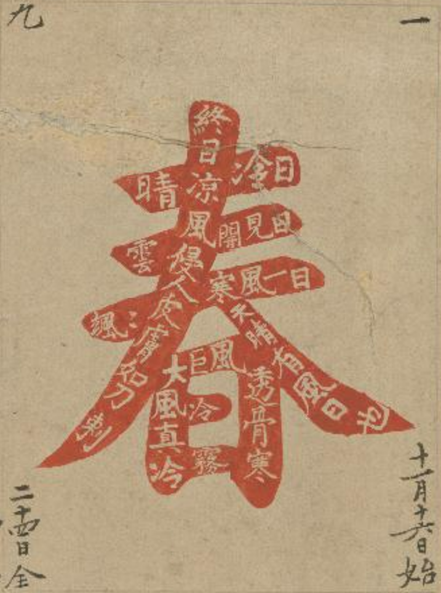道光初年,御製九九消寒圖,用“亭前垂柳珍重待春風”九字,字皆九筆也。懋勤殿雙鉤成幅,題曰”管城春滿”。內直翰林諸臣,按日填廓,細注陰晴風雪,皆以空白成字,工致絕倫。每歲相沿,遂成故事。
In the early Daoguang era [1820-1850], His Majesty created a nine-by-nine winter-repelling design with the nine characters tingqian chuiliu zhenzhong dai chunfeng which reads “low willow branches in front of the pavilion waiting in earnest for the wind of spring”, each character consisting of nine strokes. The Palace of Assiduity had it reproduced with the double-outlining technique [1] and inscribed with the headline “Spring Fills the Tube-City”.[2] The Hanlin Academicians of the inner court filled in the strokes as scheduled while making detailed notes on each day’s weather.[3] All notes were formed by leaving space,[4] creating a fine example of exquisite craftsmanship. Repeated every year, this practice has become a convention.
* From Wu Zhenyu 吳振棫 (1792-1870), Yangjizhai conglu 養吉齋叢錄 14.6b: https://ctext.org/library.pl?if=gb&file=35144&page=83.
[1] Shuanggou 雙鉤 (double-outlining) is a technique for reproducing study copies of calligraphy and painting. A shuanggou copy is created by outlining the brushstrokes of the original with thin lines. The outlining of a stroke typically requires one to draw twice (left and right edges, or top and bottom edges), hence the word “double” in the term.
[2] Guancheng 管城 (tube-city) refers to the brush pen, typically made of a bamboo tube.
[3] Starting from the winter solstice, one fills in one stroke every day, and the whole design will be finished after eighty-one days, when spring begins. As the number nine represents the maximal yang force, nine times nine reinforces the idea that this practice serves to repel the cold yin force of winter.
[4] As the example preserved in the Palace Museum in Beijing shows, the smaller characters of the notes are formed by not applying red ink to certain areas, instead of by filling a stroke with red ink and then writing the weather records in a different colour on top of the completed stroke.

A design with the words "low willow branches in front of the pavilion waiting in earnest for the wind of spring" from the 19th century
Image credit: The Palace Museum, Beijing
Another design with the words "On the verge of spring, the wind fills the chamber with the scent of cypress in the courtyard" and a close-up of the character chun 春 (spring) with weather records in smaller characters
Image credit: The Palace Museum, Beijing
High-quality digitalisation: https://www.dpm.org.cn/dyx.html?path=/Uploads/tilegenerator/dest/files/image/pm/application/15603/80652.xml
Copyright Declaration*:
The texts and images used on the website of Rachelle's Lab are either from the public domain (e.g. Wikipedia), databases with open data licenses (e.g. Shuhua diancang ziliao jiansuo xitong 書畫典藏資料檢索系統, National Palace Museum, Taipei), online libraries that permit reasonable use (e.g. ctext.org), or original work created for this website.
Although fair use of the website for private non-profit purposes is permitted, please note that the website of Rachelle's Lab and its content (including but not limited to translations, blog posts, images, videos, etc.) are protected under international copyright law. If you want to republish, distribute, or make derivative work based on the website content, please contact me, the copyright owner, to get written permission first and make sure to link to the corresponding page when you use it.
版權聲明:
本站所使用的圖片,皆出自公有領域(如維基)、開放數據庫(如臺北故宮博物院書畫典藏資料檢索系統)、允許合理引用的在線圖書館(如中國哲學電子化計劃)及本人創作。本站允許對網站內容進行個人的、非營利性質的合理使用。但請注意,本站及其內容(包括但不限於翻譯、博文、圖像、視頻等)受國際版權法保護。如需基於博客內容進行出版、傳播、製作衍生作品等,請務必先徵求作者(本人)書面許可,并在使用時附上本站鏈接,註明出處。
*Read more about copyright and permission here.





Commentaires